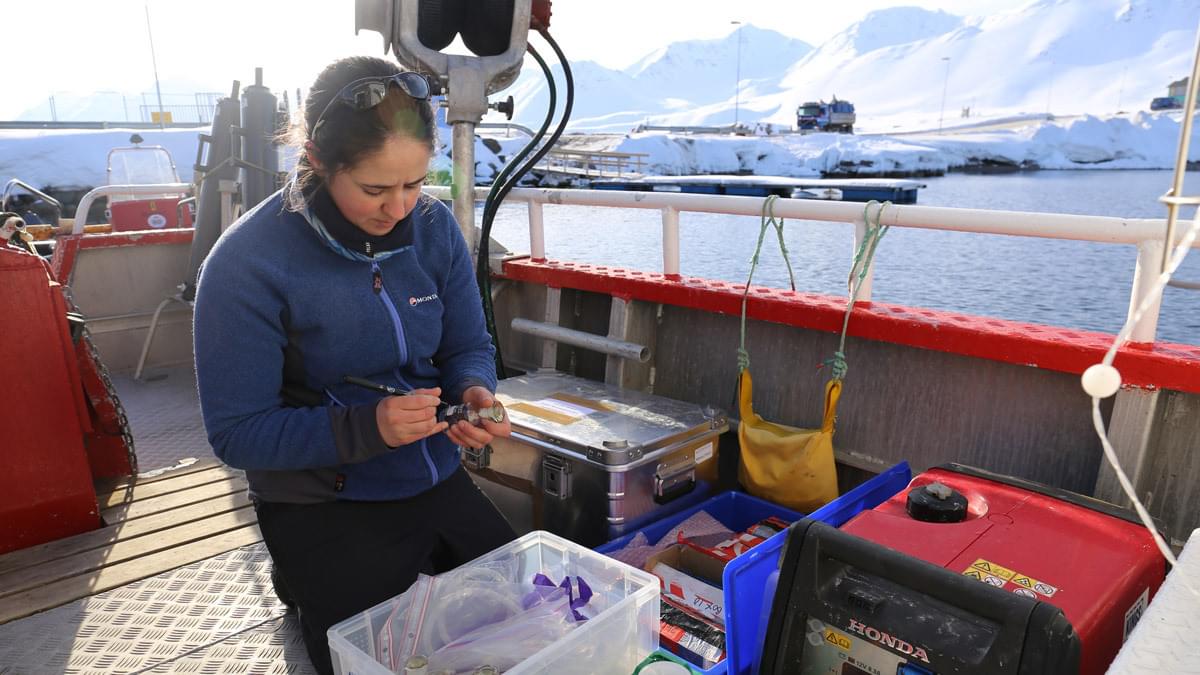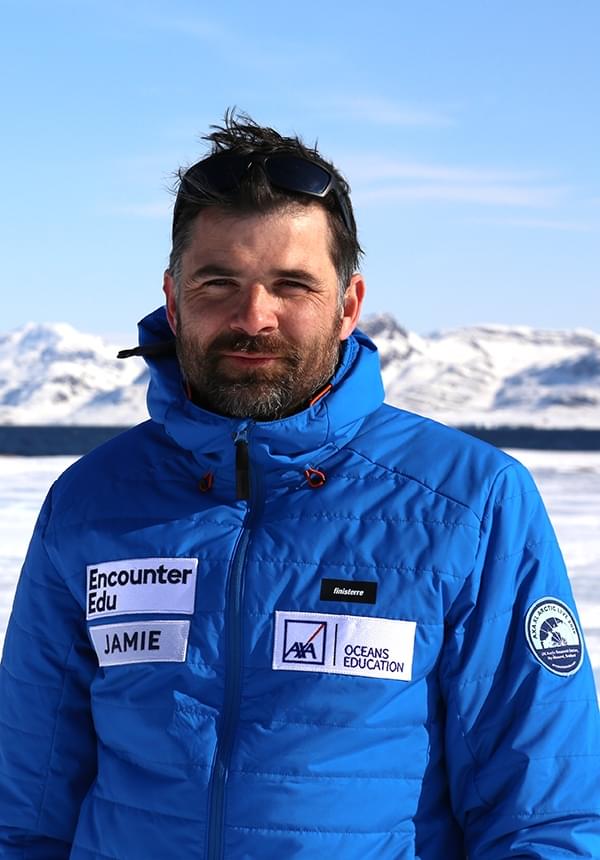
Live investigation: an 'acid' Arctic
This fun live lesson investigation aims to show how water becomes more acidic when carbon dioxide is bubbled through it. It demonstrates the link between carbon dioxide in the atmosphere and a process called ocean acidification, a change in the pH or acidity of the ocean. Students will also observe over time the effects of acid on chalk (standing in as an example of animals with ‘chalky’ structures or skeletons).
Available on catch-up
- 45 mins
- Ages 7-14 / Grades 3-8 / STEM clubs
Learning outcomes
Chemistry and biology
- Use the pH scale for measuring acidity/alkalinity
- Explain the impact of human production of carbon dioxide on the environment and climate
- Working scientifically by observing over time, and using evidence to support conclusions
Preparation
If you have never joined a live lesson before, visit the support centre, where you can find a range of technical and educational information.
This live lesson is suited to all students studying geography. The activity is based around the Ocean acidification in a cup and Dissolving ‘shells’ in vinegar activities, part of the Frozen Oceans STEAM activity collection.
The lesson assumes no prior knowledge of the Arctic, but students may find it useful to have worked through a preparatory lesson.
Questions generated by your class can be submitted via the Encounter Live tab in your profile.
Lesson steps
1. Introduction (5 mins)
Jamie will open the live lesson with a welcome and introduction to Arctic Live and the UK Arctic Research Station, as well as giving shout-outs to students and schools.
2. Subject knowledge (5 mins)
Jamie and Helen will speak about what ocean acidification is and how we can simulate an extreme version of ocean acidification right in the classroom. There will be a brief introduction to acids and alkalis and how the pH scale can be useful for comparing the acidity of liquids.
During this time students can get into their allocated groups and set up their experiments.
3. Activity time (20 mins)
Jamie will demonstrate how to set up models of the ocean to demonstrate Ocean acidification in a cup. Jamie will ask students to predict how the acidity may change. Write your answers on the live chat. Jamie will then begin the experiment.
The next step is to set up the activity to observe dissolving shells, or chalk, in an acid (in this case, vinegar). Join in the investigation live.
Helen will further discuss the significance of ocean acidification, extending the discussion to what happens to the rest of the food web if organisms such as clams and scallops were unable to grow and survive.
4. Q&A and conclusion (15 mins)
After completing the activity Jamie will be able to answer pre-submitted questions and take part in the live chat. At the end of the broadcast, Jamie will suggest some other activities you might like to try and what's coming up in the rest of Arctic Live 2022.
Free access for Teacher Plus subscribers
Free access to this live lesson is supported by AXA as part of their Action+ programme. Use the coupon code ILOVETHEARCTIC to receive free access to this lesson, and then email us with the action that you have taken:
- Made a class pledge to care for the Arctic
- Deepened your class's understanding using one or more of the Frozen Oceans investigations
- Taught one or more of the lessons from the Frozen Oceans | Science | Ages 11-14 or Frozen Oceans | Geography | Ages 11-14 units
Speakers

Jamie Buchanan-Dunlop
Executive Director, Encounter Edu
Brought to you by


With support from

Live investigation: an 'acid' Arctic
This fun live lesson investigation aims to show how water becomes more acidic when carbon dioxide is bubbled through it. It demonstrates the link between carbon dioxide in the atmosphere and a process called ocean acidification, a change in the pH or acidity of the ocean. Students will also observe over time the effects of acid on chalk (standing in as an example of animals with ‘chalky’ structures or skeletons).
Available on catch-up
- 45 mins
- Ages 7-14 / Grades 3-8 / STEM clubs
Learning outcomes
Chemistry and biology
- Use the pH scale for measuring acidity/alkalinity
- Explain the impact of human production of carbon dioxide on the environment and climate
- Working scientifically by observing over time, and using evidence to support conclusions
Preparation
If you have never joined a live lesson before, visit the support centre, where you can find a range of technical and educational information.
This live lesson is suited to all students studying geography. The activity is based around the Ocean acidification in a cup and Dissolving ‘shells’ in vinegar activities, part of the Frozen Oceans STEAM activity collection.
The lesson assumes no prior knowledge of the Arctic, but students may find it useful to have worked through a preparatory lesson.
Questions generated by your class can be submitted via the Encounter Live tab in your profile.
Lesson steps
1. Introduction (5 mins)
Jamie will open the live lesson with a welcome and introduction to Arctic Live and the UK Arctic Research Station, as well as giving shout-outs to students and schools.
2. Subject knowledge (5 mins)
Jamie and Helen will speak about what ocean acidification is and how we can simulate an extreme version of ocean acidification right in the classroom. There will be a brief introduction to acids and alkalis and how the pH scale can be useful for comparing the acidity of liquids.
During this time students can get into their allocated groups and set up their experiments.
3. Activity time (20 mins)
Jamie will demonstrate how to set up models of the ocean to demonstrate Ocean acidification in a cup. Jamie will ask students to predict how the acidity may change. Write your answers on the live chat. Jamie will then begin the experiment.
The next step is to set up the activity to observe dissolving shells, or chalk, in an acid (in this case, vinegar). Join in the investigation live.
Helen will further discuss the significance of ocean acidification, extending the discussion to what happens to the rest of the food web if organisms such as clams and scallops were unable to grow and survive.
4. Q&A and conclusion (15 mins)
After completing the activity Jamie will be able to answer pre-submitted questions and take part in the live chat. At the end of the broadcast, Jamie will suggest some other activities you might like to try and what's coming up in the rest of Arctic Live 2022.
Free access for Teacher Plus subscribers
Free access to this live lesson is supported by AXA as part of their Action+ programme. Use the coupon code ILOVETHEARCTIC to receive free access to this lesson, and then email us with the action that you have taken:
- Made a class pledge to care for the Arctic
- Deepened your class's understanding using one or more of the Frozen Oceans investigations
- Taught one or more of the lessons from the Frozen Oceans | Science | Ages 11-14 or Frozen Oceans | Geography | Ages 11-14 units
Speakers

Jamie Buchanan-Dunlop
Executive Director, Encounter Edu
Brought to you by


With support from

